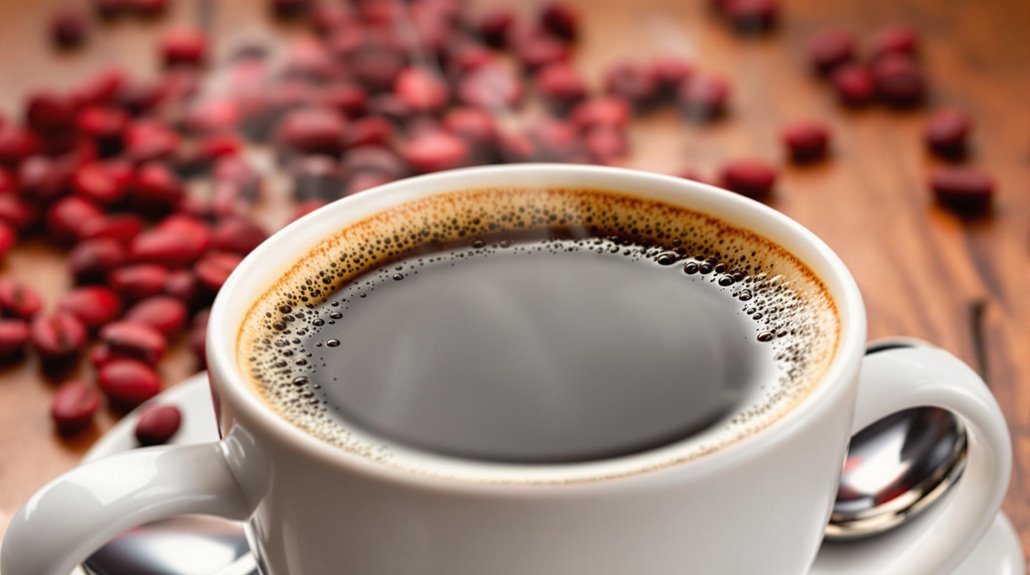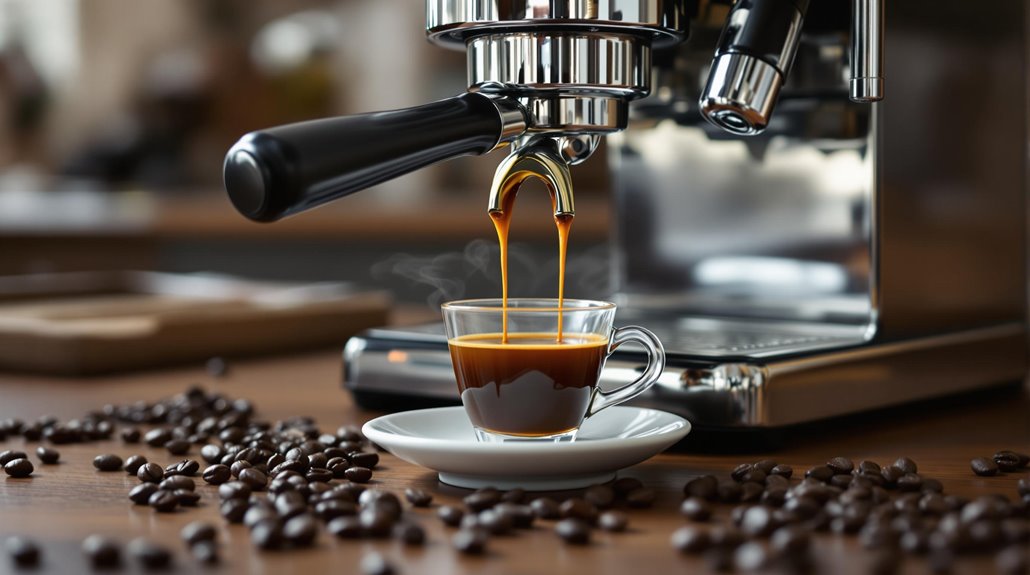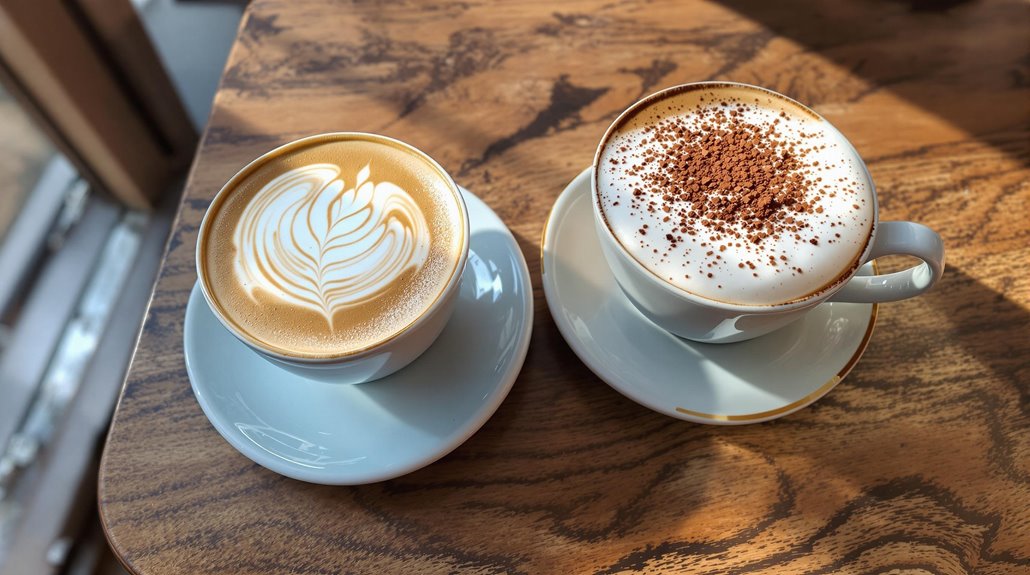







You might've heard that cold brew coffee is just iced coffee, but that's not entirely accurate. While both beverages are popular, they're made using different methods that greatly impact flavor and acidity. Understanding these distinctions could change how you enjoy your coffee. So, what exactly defines cold brew, and how do you make it? The process is simpler than you might think, yet the results are remarkably rich and smooth. Let's explore how this unique drink comes together and what makes it stand out in the coffee world.
Key Takeaways
- Cold brew coffee is made by steeping coarsely ground coffee beans in cold or room temperature water for 12 to 24 hours.
- This method results in a smooth, less bitter flavor with lower acidity, appealing to those sensitive to high-acid beverages.
- A standard coffee-to-water ratio for cold brew is 1:4, which can be adjusted for stronger or milder flavors.
- The mixture is stirred, covered, and strained through a fine mesh or cheesecloth to yield a smooth cold brew concentrate.
- Cold brew can be served iced or hot, enhanced with syrups, and should be consumed within a week for optimal freshness.
What Is Cold Brew Coffee?
Cold brew coffee is typically made by steeping coarsely ground coffee beans in cold or room temperature water for an extended period, usually between 12 to 24 hours. This lengthy steeping process extracts flavors more gently than traditional hot brewing methods. As a result, cold brew coffee showcases a smooth and less bitter flavor profile, which many coffee enthusiasts appreciate.
When preparing cold brew, you'll often find a common coffee-to-water ratio ranging from 1:4 to 1:8. This versatility allows you to customize the strength and taste to suit your preferences. After brewing, you can serve cold brew chilled, often diluting it with water or milk for a revitalizing beverage, especially during warmer months.
One of the standout features of cold brew coffee is its lower acidity compared to hot-brewed varieties. This characteristic makes cold brew easier on the stomach, appealing to individuals who are sensitive to high-acid beverages. Overall, cold brew offers a unique and enjoyable coffee experience, inviting you to explore its distinct flavor and invigorating qualities.
How Cold Brew Is Made
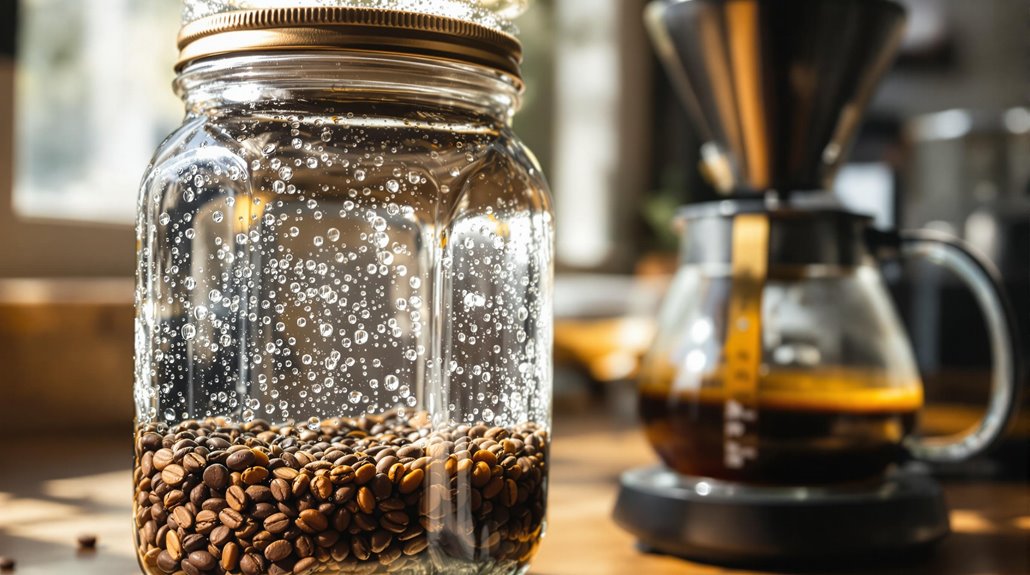
To make cold brew coffee, you start by coarsely grinding fresh coffee beans and steeping them in cold or room temperature water for 12 to 24 hours. The typical coffee-to-water ratio is 1 part coffee to 4 parts water, but you can adjust this for your preferred strength. After steeping, you'll strain the mixture to separate the liquid from the grounds, resulting in a smooth, flavorful concentrate.
Brewing Process Overview
Ever wondered how that smooth and invigorating cold brew coffee is made? The process of cold brewing involves steeping coarsely ground coffee beans in cold or room temperature water for an extended period, typically between 12 to 24 hours. For a concentrated brew, a common coffee-to-water ratio is 1:4, meaning you combine 1 cup of coffee with 4 cups of water.
To start, you'll want to gently stir the mixture to guarantee all coffee grounds are saturated. Once stirred, cover the container and let it steep for the desired time. This slow extraction method enhances the flavor profile, resulting in a less acidic and smoother taste compared to traditional brewing methods.
After the steeping time is up, it's time to strain the coffee. Use a fine mesh strainer or cheesecloth to remove the grounds, yielding a smooth, concentrated coffee. You can store this strained coffee concentrate in the fridge for up to a week. When you're ready to enjoy a cup, simply dilute it with water or milk to achieve your preferred strength.
Coffee-to-Water Ratio
Achieving the perfect cold brew coffee relies heavily on the coffee-to-water ratio you choose. A common starting point is a 1:4 ratio, where you use one part coarsely ground coffee to four parts cold or room temperature water. This method creates a concentrated brew that can be adjusted to your taste preference. If you prefer a stronger flavor, you might opt for a 1:2 ratio, which requires 1.5 cups of coffee for every 3 cups of water.
Once you've mixed your coffee and water, let the grounds steep for 12 to 24 hours. This extended steeping time allows for ideal flavor extraction from the coarsely ground coffee. After steeping, strain the mixture through a fine mesh strainer or cheesecloth to remove the grounds, leaving you with a smooth cold brew concentrate.
To customize your drink, you can dilute the concentrate with additional cold or room temperature water or milk. Adjusting the dilution not only affects the strength but also enhances the flavor, allowing you to enjoy a cold brew coffee that suits your personal preferences perfectly.
Essential Ingredients
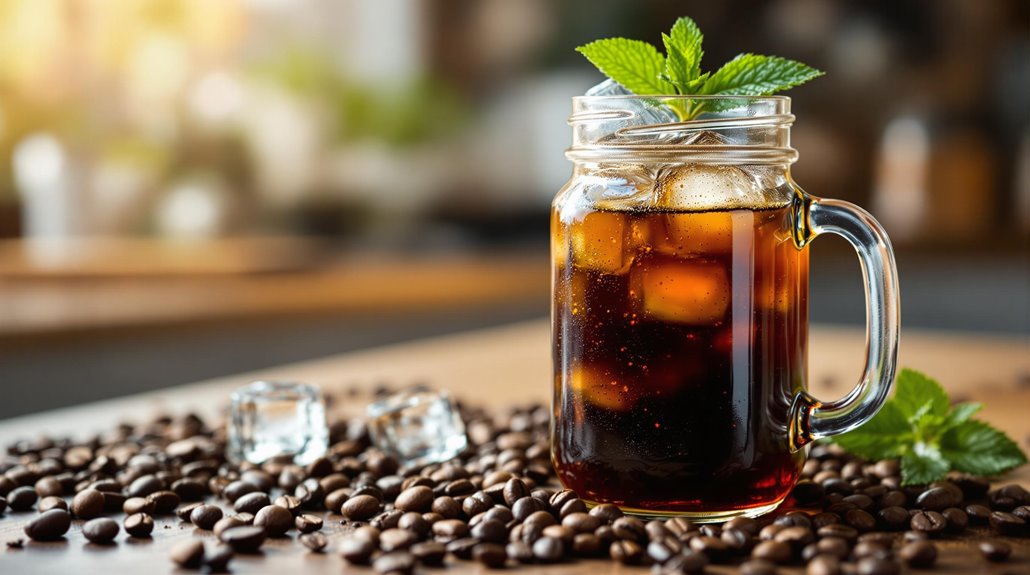
When crafting cold brew coffee, the essential ingredients play a pivotal role in determining the final flavor and quality of your brew. The primary components are coarsely ground coffee beans and cold or room temperature water. For a balanced and flavorful cold brew, a common ratio of coffee to water is 1 cup of coffee to 4 cups of water. If you prefer a stronger brew, consider using a higher ratio of 1:2, allowing you to dilute the concentrate later to taste.
Using freshly ground coffee beans is vital for ideal flavor, as they release oils that enhance the taste profile. Avoid pre-ground coffee, which may lead to uneven extraction and a gritty final product. To achieve that perfect coarse setting, grind your beans just before brewing.
It's equally important to use filtered water, as it greatly improves the quality and flavor of your cold brew. Unfiltered water can introduce unwanted impurities, affecting the overall taste. By prioritizing these essential ingredients—coarsely ground coffee and filtered water—you'll lay the foundation for a delicious cold brew experience.
Cold Brew Brewing Methods
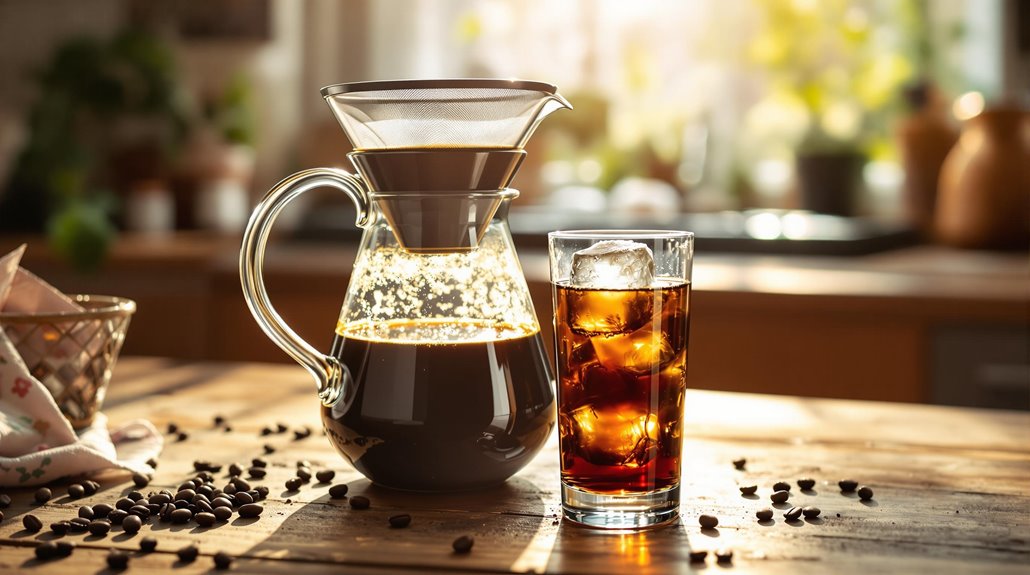
When brewing cold brew coffee, you'll find various techniques that can enhance your experience. Understanding the different methods and ratios allows you to customize your brew's strength and flavor profile. Additionally, exploring cold brew variations can lead to exciting new tastes and combinations that suit your preferences.
Brewing Techniques Explained
Cold brew coffee offers a unique brewing method that sets it apart from traditional hot brewing techniques. To make cold brew, you'll start by steeping coarsely ground coffee beans in cold or room temperature water. This process typically lasts between 12 to 24 hours, allowing the flavors to extract without the bitterness often found in hot brewing methods.
The recommended coffee-to-water ratio for cold brew is generally between 1:4 and 1:8. If you prefer a stronger concentrate, using less water will help achieve that. After the steeping period, strain the mixture through a fine mesh strainer or cheesecloth to separate the liquid coffee from the grounds, resulting in a smooth brew ready for consumption.
One of the key benefits of cold brew is its customization options. You can adjust the steeping time and dilute the final product with water or milk to match your taste preferences. Additionally, you can store cold brew in the refrigerator for up to a week, preserving its freshness and flavor profile throughout its shelf life, making it a convenient choice for coffee lovers.
Cold Brew Variations
While traditional cold brew coffee is often made using a classic immersion technique, several variations exist that cater to different preferences and brewing styles. If you're looking to make cold brew at home, the French press is a popular choice. It allows for easy steeping and straining, typically using a coffee-to-water ratio of 1:4 or 1:8 to achieve concentrated results. You can adjust the steeping time between 12 to 24 hours based on how strong you like your brew.
Alternatively, a cold brew coffee maker can streamline the process, featuring a built-in filter for controlled brewing and easy grounds separation. If you're short on time, consider the flash brew method. This technique involves brewing hot coffee directly over ice, yielding a different flavor profile while still delivering a revitalizing beverage.
Experimenting with steeping time, coffee grind size, and coffee-to-water ratios is key to customizing your cold brew. Each variation impacts the final flavor and strength, allowing you to tailor your cold brew experience to your liking.
Flavor Profile of Cold Brew
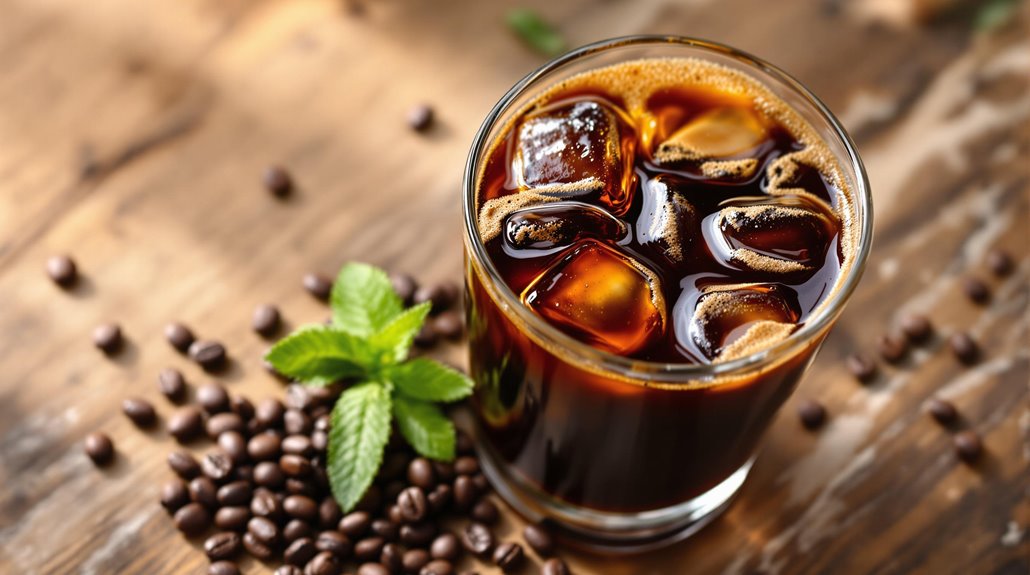
The flavor profile of cold brew coffee stands out for its smoothness and reduced bitterness, making it a favorite among coffee enthusiasts. Unlike traditional brewed coffee, cold brews undergo a unique steeping process that takes anywhere from 12 to 24 hours in cold or room temperature water. This extended steeping allows for the extraction of rich flavors while minimizing acidity, resulting in a beverage that's less bitter and more approachable.
You'll often find tasting notes of dark chocolate and low-acidity fruits in cold brews, which contribute to their mellow character. The mouthfeel is thicker and creamier, enhancing your overall drinking experience. This texture, combined with the unique flavor profile, makes cold brew an appealing option for those looking to enjoy coffee without the sharpness typically associated with hot brews.
The specific flavor notes can vary greatly based on the type of ground beans you use. Freshly ground beans release aromatic oils during the grinding process, which can elevate the taste and aroma of your cold brew. By choosing high-quality beans, you'll guarantee a rich and satisfying cup every time.
Benefits of Cold Brew Coffee
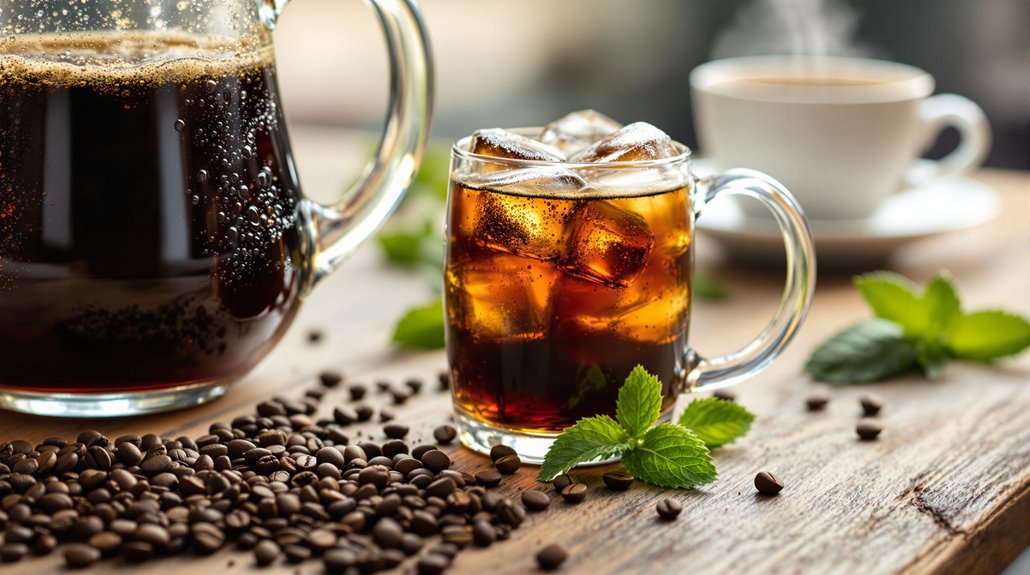
When you choose cold brew coffee, you enjoy a smooth flavor profile that's less bitter than traditional brews, thanks to its unique extraction process. Its lower acidity makes it gentler on your stomach, ideal if you're sensitive to acidic drinks. Plus, the ability to prepare cold brew in large batches offers you convenience and cost savings, letting you savor your favorite coffee all week long.
Smooth Flavor Profile
Many coffee enthusiasts appreciate cold brew coffee for its exceptionally smooth flavor profile, achieved through a lengthy steeping process that lasts anywhere from 12 to 24 hours. This extended infusion in cold or room temperature water greatly minimizes bitterness, allowing the coffee's natural qualities to shine. As a result, cold brew coffee often presents a naturally sweet flavor, as the slow extraction method highlights inherent sugars while reducing the extraction of bitter compounds.
Moreover, the creamy mouthfeel of cold brew adds to its appeal, offering a thicker and richer texture that enhances the overall drinking experience. You can easily customize your cold brew by adjusting the coffee-to-water ratio, tailoring the strength and taste to your personal preferences. This flexibility not only allows for a personalized flavor experience but also contributes to its widespread popularity.
The smooth flavor profile and invigorating qualities make cold brew coffee an excellent choice for any time of day, whether you're looking to enjoy a leisurely morning or a revitalizing afternoon pick-me-up. Ultimately, cold brew offers a delightful alternative for those seeking a gentler, more enjoyable coffee experience.
Lower Acidity Benefits
Diving into the benefits of cold brew coffee reveals its notable lower acidity, which caters to those sensitive to acidic beverages. This unique brewing method employs a cold steeping process that extracts rich coffee flavors without the harsh compounds typically found in traditional hot brewing. As a result, you'll notice a smooth taste profile that minimizes bitterness and enhances enjoyment.
For people who often experience acid reflux or heartburn, cold brew's lower acidity can be a game changer. Research indicates that this reduction in acidity may help alleviate discomfort associated with these conditions, allowing you to savor your coffee without worry.
Moreover, the gentle nature of cold brew doesn't just improve the coffee taste; it also preserves the health benefits associated with coffee consumption. You can still enjoy antioxidants without the negative effects of high acidity, making it a healthier choice for your daily caffeine fix. Ultimately, cold brew coffee offers a delicious and stomach-friendly alternative, ensuring you can indulge in your favorite drink while prioritizing your well-being.
Convenient Batch Preparation
Cold brew coffee not only offers lower acidity benefits but also excels in convenient batch preparation, making it an ideal choice for those with busy lives. By brewing cold brew in large batches, you can easily prepare multiple servings that last throughout the week. This allows you to brew coffee at home just once and enjoy it without daily effort.
The brewing process typically takes 12 to 24 hours, which means you can set it up in advance and have your coffee ready when you need it. Once brewed, cold brew concentrate can be stored in the refrigerator for up to a week, preserving its flavor and freshness.
Additionally, you can customize your cold brew by adjusting the coffee-to-water ratio, giving you the flexibility to cater to your flavor preferences. Whether you enjoy a stronger cup or a milder brew, it's all within your control.
Plus, since cold brew is less acidic than traditional coffee, it's gentler on your stomach, making it a convenient option for those sensitive to acidity. With these advantages, cold brew coffee is perfect for fitting seamlessly into your hectic routine.
Serving Suggestions
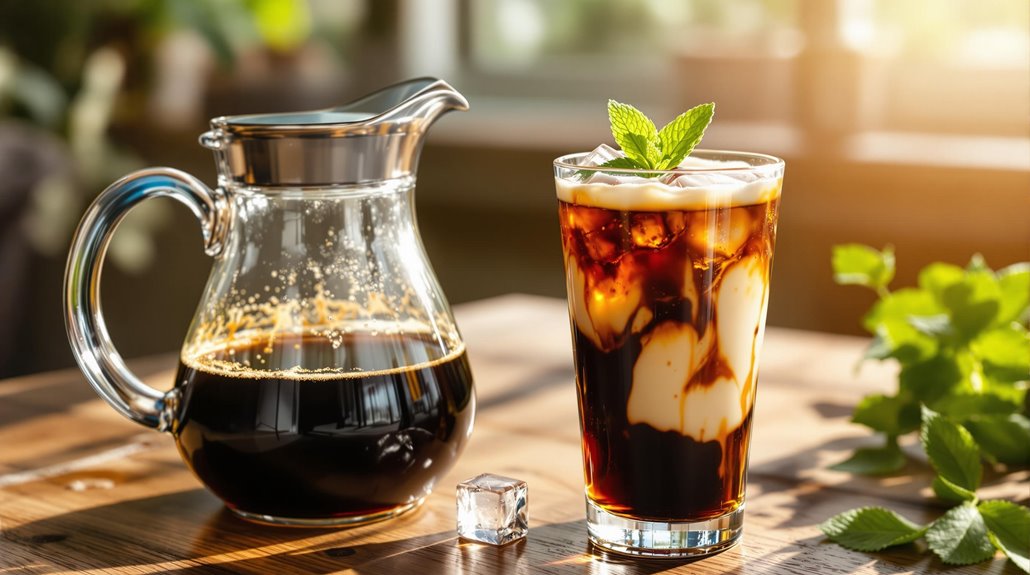
Serving cold brew coffee opens up a world of possibilities tailored to your taste preferences. You can enjoy cold brew either iced or hot, with iced cold brew often served over ice to keep it invigorating. If your cold brew concentrate is too strong, dilute it with equal parts water or milk for a smoother flavor.
When serving iced cold brew, consider using coffee ice cubes made from frozen cold brew instead of regular ice. This way, you maintain the rich taste without dilution. You can also experiment with flavored syrups, such as vanilla or caramel, to add a twist to your beverage. For an indulgent touch, garnish your drink with whipped cream or chocolate shavings.
Don't forget that cold brew coffee can serve as a versatile base for coffee cocktails. Mix it with spirits or other ingredients to create unique drinks. Additionally, pouring cold brew over vanilla ice cream transforms it into a delightful dessert. With these serving suggestions, you can customize your cold brew experience to suit any occasion or mood, ensuring every sip is enjoyable.
Tips for Perfect Cold Brew
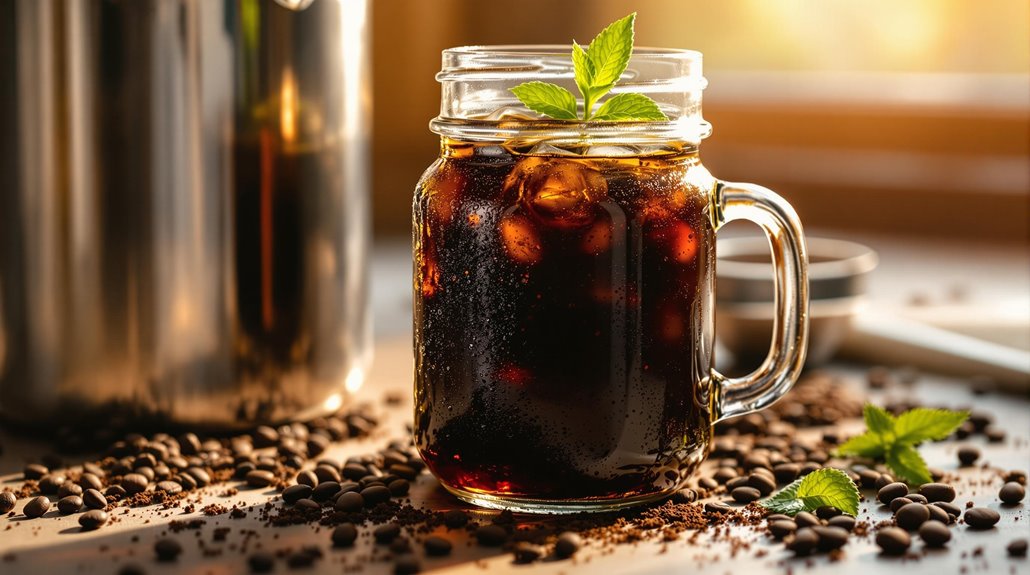
Achieving the perfect cold brew coffee requires careful attention to detail, starting with the choice of coffee grounds. You should use coarsely ground beans, as a coarse grind prevents bitterness and allows for easier straining. Next, pay attention to the coffee-to-water ratio. A ratio of 1:4 to 1:8 works best, depending on how strong you like your brew. Combine the coffee and water, then stir the mixture gently to guarantee all grounds are evenly saturated before steeping.
Steep the mixture at room temperature for 12-24 hours. This extended steeping time is vital for extracting rich flavors without the bitterness often associated with hot brewing methods. Once steeping is complete, it's time to strain your cold brew. Use a fine mesh strainer lined with cheesecloth or paper filters to remove the grounds and achieve a smooth consistency.
After straining, store your cold brew concentrate in the fridge, where it can last up to a week. Remember, before serving, you'll want to dilute the concentrate with water or milk to taste. Following these tips will help you create a revitalizing and flavorful cold brew coffee every time.
Cold Brew vs. Iced Coffee
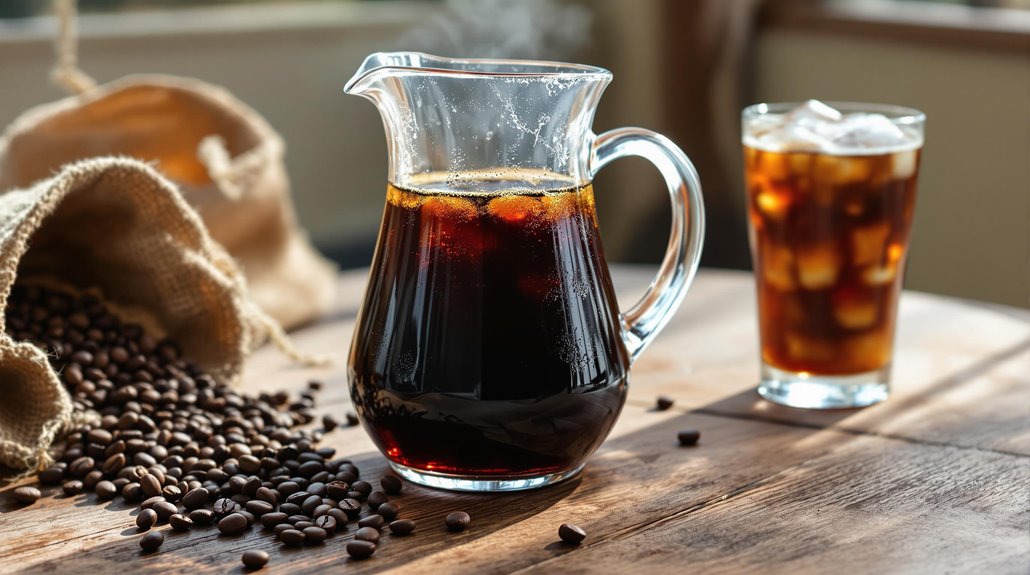
When comparing cold brew coffee and iced coffee, it is essential to recognize their fundamental differences in preparation and flavor. Cold brew is made by steeping coarsely ground coffee in cold or room temperature water for 12 to 24 hours, resulting in a smooth, less bitter taste. In contrast, iced coffee is brewed using hot coffee and then cooled down by pouring it over ice, which often retains more acidity and strong flavors.
The preparation time also highlights their differences. Cold brew requires a lengthy steeping process, while iced coffee can be made in just minutes. After brewing, cold brew is typically diluted with water or milk to adjust its strength, whereas iced coffee is usually served as brewed without further dilution.
Another significant factor is caffeine content. Cold brew often has a higher concentration of caffeine if prepared as a concentrate, commonly using a 1:4 coffee-to-water ratio. Iced coffee, on the other hand, has caffeine levels similar to regular brewed coffee. Understanding these distinctions helps you choose the right beverage based on your taste preferences and caffeine needs.
Storage and Freshness Tips
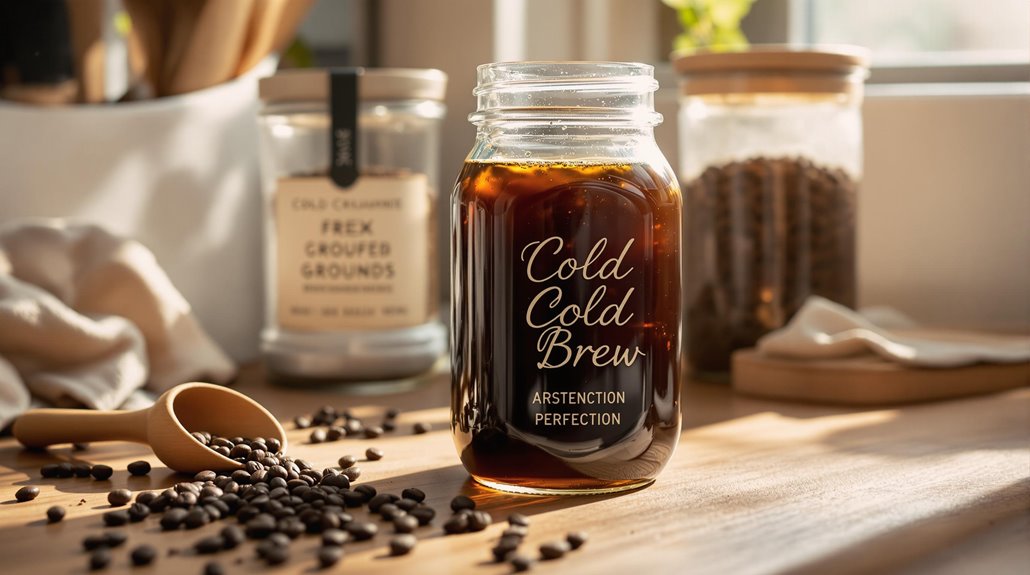
Understanding how to properly store and maintain the freshness of your cold brew coffee is just as important as knowing how to prepare it. Fresh cold brew is best consumed within one week of brewing to guarantee peak flavor. To preserve this freshness, always store your cold brew in an airtight container in the refrigerator. This minimizes oxidation and helps maintain its taste quality.
If you've prepared a cold brew concentrate, you're in luck; it can remain fresh for up to two weeks when stored correctly. However, keep in mind that its flavor may gradually diminish over time. To enjoy the best taste, consider making smaller batches that can be consumed within a few days instead of larger amounts that risk sitting for longer periods.
When serving cold brew, avoid reheating it, as it's designed to be enjoyed cold. Instead, serve it over ice or mix it with water or milk for dilution. By following these storage tips, you can guarantee that every sip of your cold brew remains flavorful and invigorating throughout its shelf life.
Disclosure: As an Amazon Associate, I earn from qualifying purchases.






